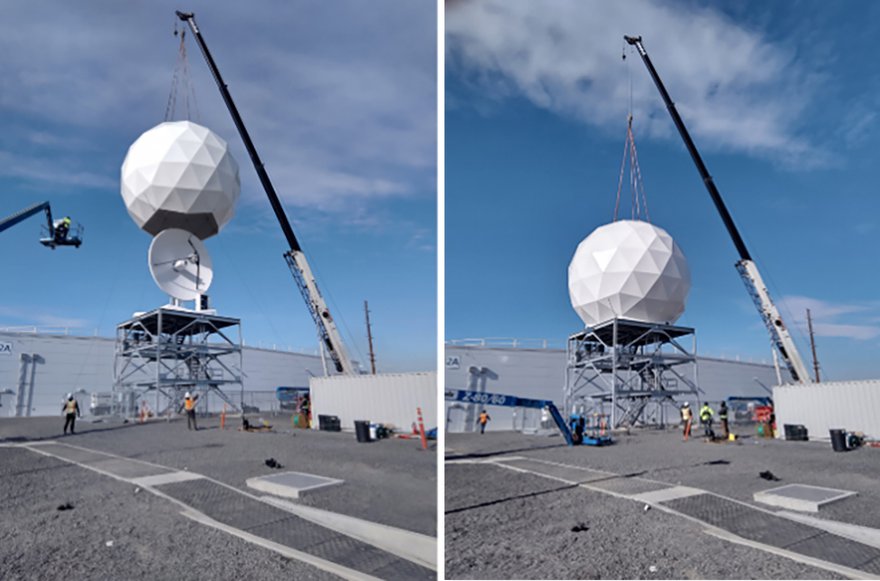With the rise of hyperscale-space offerings such as Microsoft’s Azure Orbital and Amazon’s AWS Ground Station, satellite operators and customers increasingly have the option to connect their satellites directly to the cloud.
It might be odd to see companies historically focused on servers sprouting antennas, but the goal is the same; to collect, store, and process as much data as possible.
“When you see an Amazon or an Azure investing in this, what they're really focusing on are the terabytes of data that get periodically dropped from the satellites down to Earth as they pass over a ground station,” says Robert Bell, executive director, World Teleport Association.
The same trends affecting data centers and mobile operators are now coming for ground stations, leading to changes in technology and business models, and growing levels of cooperation and cohabitation with data centers.
Where once ground stations were entirely separate and largely siloed pieces of infrastructure, they are now becoming increasingly tightly connected to and colocated at data centers as the amount of satellite data increases. At the same time, the industry is undergoing its own transformation towards virtualized infrastructure offered via an as a service model.
This article appeared in our Future of Data Center Connectivity Supplement. Read the whole thing here
Data centers with dishes
Ground stations are largely "data centers with dishes," according to WTA’s Bell. Beyond housing large amounts of compute, operating ground stations can be a capital intensive business; facilities need large footprints, good connections, and a suitable location.
Like data centers, there are different business models. Governments and telcos may have the resources to operate their own ground stations ‘on-premise;’ others will colocate their antennas alongside other companies’ infrastructure at a third party facility.
These “teleports” are analogous to Internet Exchanges or carrier hotels, hosting ground stations and providing connections to fiber networks. Increasingly, companies are sharing time on antennas via self-service portals in a model adopted from the world of cloud computing (aka Ground Station as a Service, or GSaaS).
Beyond government, TV and broadcast has traditionally been the dominant customer of satellites. Now, though, broadcast TV is losing market share to Internet-based solutions, the space sector and ground station market are seeing a boom period.
“The growth in the ground station segment – though certainly not to the size of the cloud services industry – has been driven by the amazing growth in the overall space segment in the last ten years,” says John Williams, vice president, Real-Time Earth at Viasat.
In the old days, satellites could cost $100 million, so a few million more on a dedicated antenna network was only a fraction of the total budget. Today, smallsats can be built for less than a $100,000, and put into orbit cheaply. More satellites can be built, and the ground station can become one of the largest costs of a project.
The growth, says Williams, is not tied to any one niche. Segments such as remote sensing, global broadband, environmental monitoring, SAR imagery, weather tracking, and IoT are all growing and building out new satellite capacity.
The ground segment has had to evolve and grow to support these new economics; both by building more ground stations, and also sharing antenna usage across many customers via the GSaaS model to bring down 'the cost of ground.'
“Smaller constellations and start-ups do not waste precious funds and resources on building out their own network and are fully bought into GSaaS from day one,” says Williams.
Virtualizing the ground station
While the customer base around satellites is becoming increasingly cloud-first and hardware agnostic, those same trends are also changing how ground station operators do business.
“Everything is now moving into virtualization at an incredibly fast pace,” says Bell. “There was a CEO with a great line; if you're having 10 services right now on an antenna, in the very near future you're gonna have to deal with putting 10,000 services on an antenna.”
“There's a very small number of innovators in this space and they're all working incredibly hard to try to produce antennas that can cost-effectively connect to all these different services. It's kind of like wave division multiplexing, we're gonna just pack more and more service onto the antennas we've got, because the technology is evolving for us to do that.”
At the same time, as telecoms hardware heads towards more commodity ‘plug and play’ hardware that relies on virtualization, the same trend is occurring in the ground station segment.
“It's going to look massively different in five years; every system except the actual physical antenna and the amplifier is going to be virtualized, it's all gonna be running on commodity hardware,” says Bell.
Sergy Mummert, SVP of Global Cloud & Strategic Partnerships at SES Networks, said within five to 10 years we should hopefully be seeing multi-band, multi-orbit antenna systems that allow for even more infrastructure sharing than is currently possible; a single antenna might be able to send and receive information to and from a large broadcast satellite in GEO, a communications satellite in LEO, and a small Earth Observation cubesat.
“That enables a shared infrastructure; virtualized modems and platforms. Then the most popular manufacturers are becoming much more software based, and they're differentiating more on the capabilities of their software instead of the features on their box," he said.
The switch is already happening: new business models allow for more shared infrastructure and dish time can be resold under an ‘as a Service’ offering. It’s no longer necessary to place your own dish at a teleport (though many are also developing their own dishes as well).
“New entrants have come into the market to look at how to advance ground technology, in both virtualization technology and new business models that use shared infrastructure to bring the cloud model to teleports,” says Mummert. “That’s a game-changer because it further reduces the barrier for new entrants and new applications.
“The original teleport providers would just offer you the land and power, and you invest in your own equipment. But now they're starting to see the benefits of providing their own ground station model.
“The more you can share ground station infrastructure makes it a much better investment for third parties who want to be in that business or even for the operator.”
Williams notes that while enterprises are adopting a ‘hybrid/multi-cloud’ approach to their IT infrastructure, satellite firms are also adopting a multi-provider approach to the ground segment.
“With more providers, they get increased geographic coverage to reduce latency and an overall more resilient and reliable ground network. Ten years ago, there were two primary providers for GSaaS in the entire world. Now there are at least ten; each one brings something different to the table, but the overall effect on the free market is to bring down the total cost of doing business.”
The cloud providers come for ground stations
The new wave of satellites creating huge amounts of data means the ground segment has grown in importance as the gateway to get space-created information back onto terra firma. Incumbents are adopting as a service offerings and GSaaS-native players such as Leaf.Space are appearing, but the market has also drawn interest from the cloud hyperscalers.
AWS has launched ground station services in Oregon; Ohio; Bahrain; Seoul, South Korea; Stockholm, Sweden; Sydney, Australia; Ireland; and South Africa's Cape Town. It is working with the likes of Lockheed Martin, Telespazio, and others to offer time on its dishes to operators.
Microsoft has installed its own ground station infrastructure at a number of its data centers, and has also formed a partnership with GEO and MEO satellite firm SES to host its own antennas at a number of Microsoft locations. Incumbents such as KSAT, ViaSat are working with the company to incorporate their offerings into Azure Orbital.
Google is hosting ground station infrastructure for SpaceX’s Starlink constellation, and SpaceX is also integrating its ground stations with Azure’s networking capabilities.
“The cloud providers are focused on trying to transform infrastructure; and when they saw all the advancements on the space side, they said your ground infrastructure hasn't advanced at all, and so this is where they wanted to invest,” explains Mummert.
While communications satellites – including Amazon’s own Kuiper Project – are obviously part of the picture, the original drive to connect the cloud to space was largely driven by the rise of Earth Observation players and their cloud-first mentalities.
“Cloud service providers offer two primary services, storage and compute. Satellite operators are voracious customers for both of those services,” says Viasat’s Williams. “Once downlinked, satellite imagery must be demodulated and processed into raw imagery and stored. There is a very significant market for geospatial intelligence analysis; taking imagery and transforming it into meaningful, actionable information.”
Mummert notes that adding new capacity through the hyperscalers offers lower latency and a way to process and analyze data in a far quicker and more direct way than previously possible.
“For the Earth observation players, most of their ground stations are in the poles, and so their latency in getting data to the end user was 30 to 45 minutes and some even longer. Ground stations away from the poles quickly improves things for customers who want much more real-time information.”
“Of course then, if it's provided by a cloud provider, then the processing of that data is improving and more and more analytics partners on their clouds bring special ways to look at the data.”
Mummert said that the shared antenna infrastructure is mostly for Earth Observation satellites at the moment. Communications satellites don’t usually share dishes in the same way currently, but will follow suit in the future.
“The issue right now is most of the communications broadband operators take so much of the antenna time so it's hard to even share it,” he says. “Over time the plan is to build enough of them that they can be shared.”
Deploying ground stations at data centers
While Microsoft’s Azure Orbital and AWS’ Ground Station service are providing an ‘as a Service’ model to a number of operators to communicate with their satellites, Microsoft and Google are also providing space for third parties to host their own infrastructure at the hyperscalers’ data centers.
Mummert said SES was looking to deploy ground infrastructure for its new O3b mPOWER communications satellite system network around the time Microsoft was exploring space as a business opportunity.
“We were in the middle of our planning cycle for mPower, and Microsoft was looking to enter the space business. It was the right timing.”
SES says due to timing it was limited to placing infrastructure in places that Microsoft was already developing data centers that made sense for the company – away from interference-heavy metros for example – while in future the company can plan further ahead based on Microsoft’s future development plans and where they align with customer needs.
“We have telco or MNO customers that also want to their own gateway when they buy capacity. Turns out some of those telcos are already partnered with a cloud provider, so there's some alignment there that we can look at. There'll be more data gateways, but they don't have to be the size of what our initial gateways are.”
While the hyperscalers have been keen to embrace the ground station and space sectors, so far there’s been little movement from other providers to follow suit.
“I would be stunned if a whole bunch of other cloud or data center providers didn't [look to colocate more ground station infrastructure at facilities],” says QTA’s Bell.
“When somebody comes and says they will pay to push a dish on your roof and they'll manage all the mystery for you and you'll get it as a port on your router, why would you ever say no?”
Earlier this year Equinix said that the company is often approached by satellite firms about installing ground station infrastructure yet seemingly is largely uninterested.
“It’s primarily an issue of managing space, weight, and interference. A clear sky view is always necessary,” said Jim Poole, Vice President of Business Development at Equinix.
Mummert says colocation of ground stations and data centers is a driver in emerging markets where data centers “have more opportunity,” but avoiding retrofits is key for making the economics more attractive.
“What we've learned in terms of the work we've done to date with Microsoft is your best bet is to develop the design for your ground station in with the data center, before the concrete is poured from the data center.”
“Any type of update to a data set is very expensive, but if you're part of the original, it's a rounding error in terms of adding the ground station.”
Customers and competition
The arrival of cloud players is changing the ground station segment’s thinking around potential partners and competition, and also customer relationships.
“The industry is working very carefully with customers to make decisions about what data needs to be on-premise, and what data they prefer to have on the cloud,” notes WTA’s Bell.
Mummert says the addition of SES infrastructure at Microsoft locations offers more capabilities to customers, enabling them to discuss how they approach data and computing. It also allows SES to send customer data directly through the Azure backbone, which avoids a connectivity step such as a VPN or purchasing an additional port.
“Suddenly, you're getting into how the cloud actually works for your end customer. That's a whole different conversation than going 'how do I get you from point A to point B?'
“These are whole new conversations with our customers that, in the past, were almost the customer's problem and we wouldn't step in to see how to optimize it.”
Mummert acknowledges that SES customers might not be Azure customers; ground station providers have to be as ‘cloud neutral’ as possible, and so the company is a direct connect partner with AWS and is in the process of doing the same with Google.
“We understand that our customers drive the cloud decisions, so the way that we talked about optimizing the network has to be the same.”
On the subject of whether these companies become competition when offering similar services, SES’ Mummert says that these are customer-driven decisions, and many customers are seeking to use multiple orbits and multiple systems in a complementary way to provide greater resiliency and different services for different use cases.
Viasat’s Williams notes that while the company is focused on developing cloud-based solutions he says are “ideal” for antennas colocated at data centers, there will always be a demand for ground stations elsewhere.
“Antennas at data centers is not a panacea as most data centers are located in the mid-latitudes,” he says. “While accessibility to a data center is great, geography is key when it comes to the ground segment. Data centers are not typically sited with customer downlink considerations in mind and they are not often near the 'strategic' geographic locations.
“Locating data centers is a compromise adopted by the cloud providers to get data into the cloud quickly, which is where the cloud providers make their money. But it is not an optimal decision for the satellite customers.”
WTA’s Bell notes as well that teleport and ground station operators can be a neutral connection partner; the operators can deal with the connectivity and relationships with the cloud providers, or in some cases even be the cloud provider.
“SES has done a number of deals with broadcast customers in developing nations, where it's the cloud service provider,” he says.
“Of course it's not really; it's reselling its Direct Connect relationships. But the broadcasters trust SES. And that's been a driver for a lot of business.”







